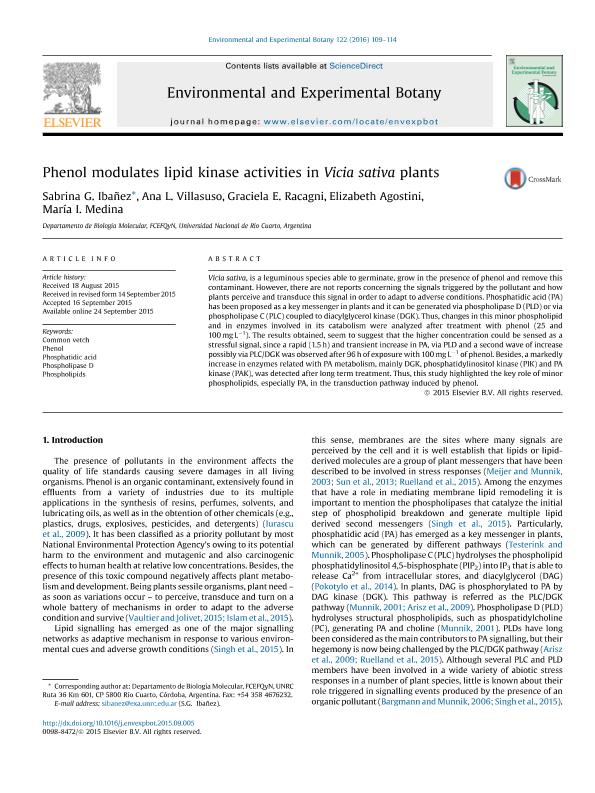Artículo
Phenol modulates lipid kinase activities in Vicia sativa plants
Ibañez, Sabrina Guadalupe ; Villasuso, Ana Laura
; Villasuso, Ana Laura ; Racagni, Graciela Esther; Agostini, Elizabeth
; Racagni, Graciela Esther; Agostini, Elizabeth ; Medina, María I.
; Medina, María I.
 ; Villasuso, Ana Laura
; Villasuso, Ana Laura ; Racagni, Graciela Esther; Agostini, Elizabeth
; Racagni, Graciela Esther; Agostini, Elizabeth ; Medina, María I.
; Medina, María I.
Fecha de publicación:
03/2016
Editorial:
Pergamon-Elsevier Science Ltd
Revista:
Environmental and Experimental Botany
ISSN:
0098-8472
Idioma:
Inglés
Tipo de recurso:
Artículo publicado
Clasificación temática:
Resumen
Vicia sativa, is a leguminous species able to germinate, grow in the presence of phenol and remove this contaminant. However, there are not reports concerning the signals triggered by the pollutant and how plants perceive and transduce this signal in order to adapt to adverse conditions. Phosphatidic acid (PA) has been proposed as a key messenger in plants and it can be generated via phospholipase D (PLD) or via phospholipase C (PLC) coupled to diacylglycerol kinase (DGK). Thus, changes in this minor phospholipid and in enzymes involved in its catabolism were analyzed after treatment with phenol (25 and 100mgL-1). The results obtained, seem to suggest that the higher concentration could be sensed as a stressful signal, since a rapid (1.5h) and transient increase in PA, via PLD and a second wave of increase possibly via PLC/DGK was observed after 96h of exposure with 100mgL-1 of phenol. Besides, a markedly increase in enzymes related with PA metabolism, mainly DGK, phosphatidylinositol kinase (PIK) and PA kinase (PAK), was detected after long term treatment. Thus, this study highlighted the key role of minor phospholipids, especially PA, in the transduction pathway induced by phenol.
Palabras clave:
COMMON VETCH
,
PHENOL
,
PHOSPHATIDIC ACID
,
PHOSPHOLIPASE D
,
PHOSPHOLIPIDS
Archivos asociados
Licencia
Identificadores
Colecciones
Articulos(CCT - CORDOBA)
Articulos de CTRO.CIENTIFICO TECNOL.CONICET - CORDOBA
Articulos de CTRO.CIENTIFICO TECNOL.CONICET - CORDOBA
Citación
Ibañez, Sabrina Guadalupe; Villasuso, Ana Laura; Racagni, Graciela Esther; Agostini, Elizabeth; Medina, María I.; Phenol modulates lipid kinase activities in Vicia sativa plants; Pergamon-Elsevier Science Ltd; Environmental and Experimental Botany; 122; 3-2016; 109-114
Compartir
Altmétricas



